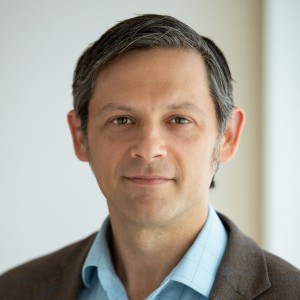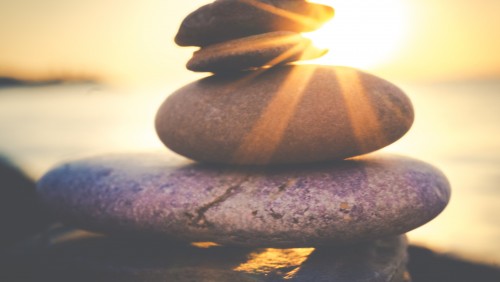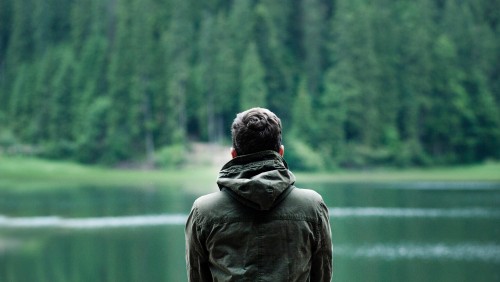Well, it’s that time of year again where my reaction times are not only too quick, but also incongruent with my surroundings (see my previous entry in this series for a more comprehensive explanation). At least once a year I find it helpful to hit the reset button in a big way and, for me, that means a few days of silent meditation. I recently spent five such days at the Insight Meditation Society in Barre, Massachusetts. I once heard Alan Watts in a recorded talk say something like, “Psychotherapy is what they call Buddhism in the West” and this idea makes a lot of sense to me. Many mental health conditions seem to be problems of not being able to observe experiences the way they really are, and many Buddhist practices and principles emphasize this very challenge. Instead of being present with our experiences, we run with our conditioned interpretations of them, and this leads us into the behaviors that cause us more suffering.
OCD in particular seems to highlight this phenomenon. Unwanted intrusive thoughts make themselves known and sweep OCD sufferers away into dream-like (or more accurately nightmare-like) narratives of analysis, avoidance, ritual, compulsion, and certainty seeking.
So, while we have multiple variations on evidence-based treatment approaches, the destination remains the same – see thoughts for what they are, see feelings for what they are, see sensations for what they are, and don’t get lost in your stories. So I recently spent five days doing only this practice.
Each day was made up of meditating while sitting, walking, eating, listening to Buddhist stories and lessons, and engaging in a few other light activities, all with the singular prompt of being in the moment and observing what arises.
Well, that certainly spiked my attention!
On the morning of the first full retreat day, I decided to take a walk along one of the many beautiful western Massachusetts forest trails behind the retreat center. Feeling the cool air on my face, hearing the soft crunch of pine needles beneath my feet, smelling the winter air, I was aware of seeing. At some point, what I seemed to be seeing about 20 feet ahead of me on the trail was some kind of raccoon. No, it was brown and too big to be raccoon. But it wasn’t a bear and it wasn’t a dog. It appeared to be some kind of beaver? Hard to say, some kind of squat, fat, slow moving giant rodent better observed from afar than made friends with. As I marveled at my weird alien friend from behind a tree, another hiker marched past me, coming within just a few feet of the fuzzy monster before they made eye contact. Dissatisfied with the attention, the creature made an about-face and started galloping (waddling aggressively) down the trail towards me. I stepped off the trail a few feet, not wanting to be between it and, well, anything. Then it stopped and looked deep into my soul. It was apparently a sentient Muppet bred over millions of years to look like a character from Clive Barker’s Nightbreed (look it up, this is a good description). It was, in fact, a large porcupine. As all wild animals do when they meet me, this well-defended forest dweller eventually rolled its eyes and went about its way, far less impressed with me than I was with it. In the moments of direct eye contact with this being though, there was a brief but unmistakable sense of oneness. It sounds like new age “woo woo”, I know, but even just a few seconds of pure concentration on a single experience has a huge impact. It was purely being present with nature, something most of us get far too little of.
Think of those moments you’ve truly let go and felt the sand between your toes at the beach, watched a snowflake land in your palm, or had the sun peek out from behind the clouds to warm your face. It’s in these moments that we become acutely aware of being alive without all the judgment, doubting, comparing, and other stories that distract us.
Porky there doesn’t see me as a series of emails that need replying to and for that moment, I stopped seeing myself that way too.
Lettuce rejoice
Every meditation retreat involves being assigned a daily chore, another place to practice mindfulness besides sitting, walking, and eating.
My job this go-around was to help prepare the salad for the next day’s lunch. There was a team of three of us; one to cut the lettuce, one to wash it, and one to dry and store it. As the chopped lettuce was dropped into a cold bowl of water, I slapped on some rubber gloves and reached in to agitate the dirt off the leaves. I could feel the intense coldness of the water and hear the dripping sounds as I lifted the lettuce out of the bowl and dropped it into a giant salad spinner.
Then I had the admittedly fun high-tech job of turning the handle that spun the salad and scared the water right off it. Next, I passed the lettuce on to another silent retreatant who gently patted the leaves with a towel and put them mindfully in a bucket. Lots of opportunity for mindfulness practice here, but also noteworthy was my comparing mind. This job was not as cool as last retreat’s yogi job of keeping the tea cannisters full or the previous visit’s job of emptying the compost bucket.
Lettuce? Boring! Oh well, just try to pay attention, I thought.
Fast forward to lunch the next day and I am waiting in line at the buffet, answering emails in my head, judging myself for not being enlightened, doubting that this will be a rewarding experience, the usual noise. I was lost in thought until suddenly I realized I was standing in front of a giant salad bowl. “
That’s my lettuce!” my mind exclaimed.
It was a surprise, a shocking recognition that this lettuce and I went way back. We had history. I then gently corrected myself, not wanting to over-identify or be possessive. “
That’s the famous lettuce!” my mind offered up in support.
Now this might not seem like a momentous occasion to the average person, but waking up to what’s real and in front of you is literally the cure for what ails us. I had been in a trance, but then suddenly I was in relation to something, I was connected to the lettuce. Like the shedding of stories that happens when we connect with nature, these small moments of recognizing something new to pay attention to can be transformative. The lettuce and I both came from somewhere, and we were together in these precious moments just before—as is the nature of things—one of us inevitably ate the other.
A real pain
In my line of work, we spend an awful lot of time seated, leaning slightly to the right, right arm elbow pressed into an armrest, right leg crossed over left leg, right hand stroking chin contemplatively – or at least I do. It’s the therapist’s or active listener’s pose. Turns out there are some consequences to this pose, which is to say that when you then try to spend more than 20 minutes seated with your back straight, your right scapula imagines it’s being stabbed. But when you sit cross-legged on a cushion, your left hip threatens to pop out of its socket and your left foot goes completely numb. I may be a balanced individual, but I’m not really balanced. OK, I’m probably just not balanced generally.
What’s interesting about sitting for long periods of time with the main instruction being to observe what arises, is that physical pain has a way of showing up on the stage like it knows it deserves more attention than mental or emotional pain.
Much debate has been had around mental health parity and the importance of treating mental health as seriously and effectively as the medical field treats physical health. Yet, internally, most of us don’t practice this. We put off addressing mental health needs when physical health needs, however small, jump to the front of the line.
People with OCD and related conditions often describe their unwanted thoughts and images as “painful” precisely because of the bluster and intrusiveness with which these thoughts and images announce themselves. In other words, they are described as painful because they are like pain. As I did my best to view the pain in my back, hip, or knee with non-judgmental openness, I noticed there was more than tightness and discomfort involved. There was also the thought of how the dominance of the pain was interfering in my ability to be mindful.
“I came all this way for enlightenment, and this is ruining my journey! I get this number of days to take off work for my piece of the mindfulness pie, and I deserve it. This is unacceptable and a waste and nothing goes my way and this is probably just some gimmick anyway and I’m just some loser with a bunch of self-help books and a 10% Happier app—where’s my 10%???” Something along those lines.
On meditation retreats of more than two or three days, there is typically at least one opportunity to meet in a small group and ask one of the teachers a question about the practice. I used this opportunity to ask my teacher about the phenomenon of pain hijacking my experience. The teacher adeptly noted that there were two objects of attention to acknowledge. There was the sensation and then there was, as he put it, something that it’s like to be separate from what you want. I wanted a specific type of experience, but I was getting a different one. I was aware of the anger and irritation, but I was not fully allowing myself to be aware just of the wanting and the separation from what I wanted. I think this is an immensely useful consideration for problems associated with many mental health conditions. We may be minding our own business when an unpleasant thought arises, and we go straight to wishing the thought weren’t there and strategizing compulsive ways to eliminate or neutralize it. We miss the opportunity to pause and observe that space in between being with what we planned and being with what we did not plan. In that space, where we reach out and try to close that separateness, there may actually be an opportunity for reflection, for self-compassion, for recognizing that being separate from what we want is part of the human condition.
Also, for the pain, he said I could just lie down instead.
Practice makes practice
So what do porcupines, lettuce, and back pain have to do with each other? Let’s hope I figure it out before the end of this blog. Correction. It’s perfectly clear what they have to do with each other. They are all opportunities for practicing mindfulness. Whether the suffering is driven by OCD, another mental health condition, other life stressors, or just being human, it comes predominantly from the space between what we can observe in the present moment and what we think it has to do with the past or future. To understand what happens in this space, we must do research. For those new to meditation, I encourage you to look at it in this way, as a form of internal data collection. Don’t worry about how focused or concentrated you are, just take a look at what is there and see for yourself what is possible. By practicing staying in the present, exactly as it is, we can experience the majesty of wildlife alongside the fear of being punctured to death by quills. We can experience the awesomeness of being connected with earth, all while doing boring food prep. We can even learn about ourselves and hold ourselves in kindness while experiencing pain. This is the practice and why I will keep at it.
This is Part Four in a series on mindfulness and meditation. See articles below for previous entries.
Meet the Author
-

Jon Hershfield, MFT
Director, The Center for OCD and AnxietySpecialties:Anxiety Disorders, Cognitive Behavioral Therapy, Obsessive-Compulsive Disorder (OCD)
-
My Takeaways from Days of Silent Meditation: Part Three
Mental HealthPublished:It had been three years since I returned to a silent meditation retreat, thanks to COVID. Yes, I meditated quite regularly over these years, but I have come to view…
-
My Takeaways from Days on Silent Meditation: Part Two
Mental HealthPublished:Jon Hershfield, MFT shares his firsthand experience with mindfulness and how he uses it for OCD.
-
My Takeaways from Days of Silent Meditation: Part One
Mental HealthPublished:Mindfulness, or learning to view thoughts and feelings as observable phenomena instead of “the truth” or “threats,” has been instrumental in my journey through OCD…


